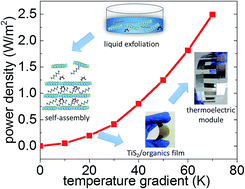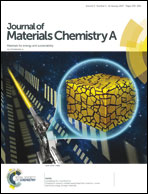A solution-processed TiS2/organic hybrid superlattice film towards flexible thermoelectric devices†
Abstract
Liquid-exfoliation has proven to be a scalable and versatile technique to produce high-yield two-dimensional nanosheets in graphene, BN, layered perovskites and transition metal dichalcogenides. This also provides new insights into the construction of novel nanoelectronics and nanophotonics through the assembly of nanosheets. Here we present a simple exfoliation-and-reassembly approach to produce a flexible n-type TiS2/organic hybrid film for low-temperature thermoelectric applications. The obtained film shows a superlattice structure with alternative layers of TiS2 and organic molecules. Charge transfer occurs when TiS2 and organic molecules form intercalation complexes, which gives rise to a high electrical conductivity but a low Seebeck coefficient. However, the power factor can be further enhanced by annealing the film under vacuum, and the value reaches 210 μW m−1 K−2 at room temperature in this study. Our flexible thermoelectric device can generate a high power density of 2.5 W m−2 at a temperature gradient of 70 K, which hits a new record among organic-based thermoelectric devices.



 Please wait while we load your content...
Please wait while we load your content...